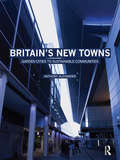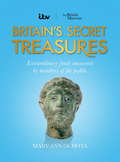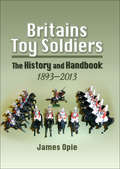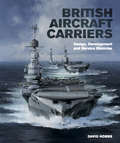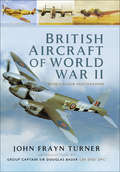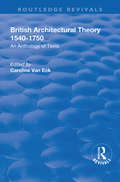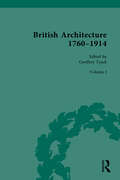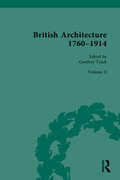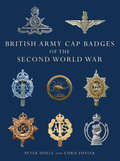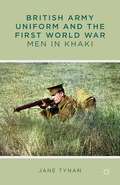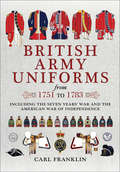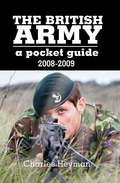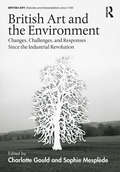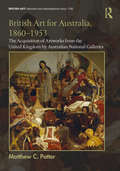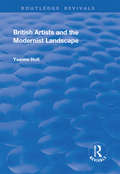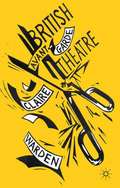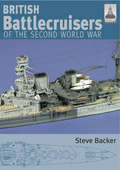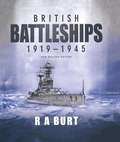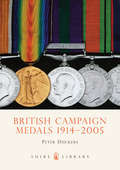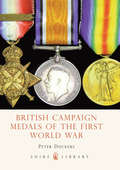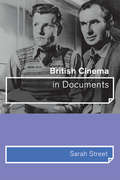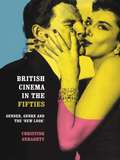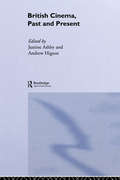- Table View
- List View
Britain's New Towns: Garden Cities to Sustainable Communities
by Anthony AlexanderThe New Towns Programme of 1946 to 1970 was one of the most substantial periods of urban development in Britain. The New Towns have often been described as a social experiment; so what has this experiment proved? This book covers the story of how these towns came to be built, how they aged, and the challenges and opportunities they now face as they begin phases of renewal. The new approaches in design throughout their past development reflect changes in society throughout the latter half of the twentieth century. These changes are now at the heart of the challenge of sustainable development. The New Towns provide lessons for social, economic and environmental sustainability. These lessons are of great relevance for the regeneration of twentieth century urbanism and the creation of new urban developments today.
Britain's Secret Treasures: Extraordinary Finds Uncovered by Members of the Public
by Mary-Ann OchotaFor hundreds of thousands of years our ancestors have walked these isles burying, dropping and throwing away their belongings, and now these treasures lie waiting for us, keeping their secrets until we uncover them once more.<P><P>Every year, hundreds of valuable artefacts are discovered by ordinary members of the British public. Here in Britain's Secret Treasures, which accompanies the ITV series, the British Museum chooses eighty of the most fascinating finds ever reported and Mary-Ann Ochota shares with us the moving histories that bring each piece to life. There is also a detailed chapter showing you how you can get involved in archaeology too. <P>From hoards of Roman gold and Bronze Age drinking vessels to tiny Viking spindle whorls and weapons from dozens of wars, all manner of treasures are described here. Some help prove that our ancestors were alive over half a million years ago, some saw their modern-day finders receive a generous reward, all provide an insight into the wonderful, dynamic, colourful history of our nation.
Britains Toy Soldiers: The History and Handbook, 1893–2013
by James OpieThis is the first full-colour history of the world-famous toy soldiers to chart the whole story of their development from Victorian table toy to 21st Century collectable. Prior to 1893 the family toy business of the Britain family was struggling as the toy industry was dominated by German manufacturers and importers. Then came the fateful decision first to import, then to design and manufacture, toy soldiers, an area the German firms were particularly strong in. Britains Toy Soldiers were born and soon their boxes stamped with the slogan 'Best Quality English Make' were being eagerly opened by little boys across Britain and then around the world. The rest, as they say is history and it is all captured here by James Opie, the world's leading expert on the subject, as he lovingly traces the varying fortunes of arguably the most famous British toy company. Illustrated with lavish colour photographs, many of them featuring items from the author's own collection, the book includes feature sections such as collectors' favourites and prices, high-value and famous sets, artistic highlights, quirks and mysteries. It is without doubt the most authoritative book on the subject and will be welcomed by the thousands of devoted collectors world wide as well as many more with fond memories of childhood battles with these beautiful toys.
British Aerospace Hawk: Armed Light Attack and Multi-Combat Fighter Trainer (Profiles Of Flight Ser.)
by Martin W. Bowman Dave WindleFor many years the worlds finest aerobatic team, the RAFs Red Arrows, have thrilled millions with their demonstrations of this fine aircraft's agility and maneuverability. Black Hawks can also be seen in the valleys of Wales, flying ground-hugging flight paths along the valleys. These are the aircraft used to teach flying perfection to new generations of fighter and ground-attack pilots. The aircraft has earned millions of pounds, being exported to many overseas countries.This book contains the world famous color profiles created by Dave Windle of the type in different operational modes, configurations and color schemes. Martin Bowman has written detailed descriptions and photographs to create the perfect enthusiasts reference.
British Aircraft Carriers: Design, Development & Service Histories
by David Hobbs&“This superb book . . . will undoubtedly become the definitive volume on British Aircraft carriers and naval aviation . . . magnificent.&”—Marine News This book is a meticulously detailed history of British aircraft-carrying ships from the earliest experimental vessels to the Queen Elizabeth class, currently under construction and the largest ships ever built for the Royal Navy. Individual chapters cover the design and construction of each class, with full technical details, and there are extensive summaries of every ship&’s career. Apart from the obvious large-deck carriers, the book also includes seaplane carriers, escort carriers and MAC ships, the maintenance ships built on carrier hulls, unbuilt projects, and the modern LPH. It concludes with a look at the future of naval aviation, while numerous appendices summarize related subjects like naval aircraft, recognition markings and the circumstances surrounding the loss of every British carrier. As befits such an important reference work, it is heavily illustrated with a magnificent gallery of photos and plans, including the first publication of original plans in full color, one on a magnificent gatefold. Written by the leading historian of British carrier aviation, himself a retired Fleet Air Arm pilot, it displays the authority of a lifetime&’s research combined with a practical understanding of the issues surrounding the design and operation of aircraft carriers. As such British Aircraft Carriers is certain to become the standard work on the subject. &“An outstanding highly informative reference work. It is a masterpiece which should be on every naval person&’s bookshelf. It is a pleasure to read and a pleasure to own.&”—Australian Naval Institute
British Aircraft of World War II
by John Frayn TurnerThis unique book, now republished, was the first of its kind to be published on British aircraft of the Second World War. Aviation enthusiasts and aero-modellers can see British aircraft as they really were, through magnificently reproduced colour photographs. Each of the forty-nine types of aircraft is accompanied by a brief 'biography' together with tables of the most important marks and their specifications, engine, span, length, height, weight, crew number, maximum speed, service ceiling, normal range and armament. There is also a section on British aircraft in action, which includes accounts of outstanding exploits by the pilots of different types. John Frayn Turner, the well-known aviation author, has chosen the pictures and provided the text.
British Architectural Theory 1540-1750: An Anthology of Texts
by Caroline Van Eck Christy AndersonThis title was published in 2003.Although it is often assumed that British writing on architectural theory really started in the 18th century, there is in fact a large corpus of writing on architecture pre-dating the introduction of Palladianism by Lord Burlington. Some of it, such as the English editions of Serlio and Palladio, belongs to the Vitruvian tradition. But many texts elude such easy classification, such as the prolonged (but hardly studied) discussions on church architecture, which are both in form and content very different from the way that theme was handled in Italian Renaissance treatises. This collection of English writing on architecture from 1540 to 1750 offers a large selection of fragments, some of them never published before. They discuss the nature of architecture, the practicalities of building, the sense of the past, religious architecture and classicism.
British Architecture 1760–1914: Volume I: 1760-1830
by Geoffrey TyackThis volume of primary sources examine British architectural history from 1760 to 1830. It contains a mixture of architectural treatises, biographical material on architects, works on different types of building, and contemporary descriptions of individual buildings and will be of great interest to students of Art History and Architecture.
British Architecture 1760–1914: Volume II: 1830-1914
by Geoffrey TyackThis volume of primary sources examine British architectural history from 1830-1914. The collection contains a mixture of architectural treatises, biographical material on architects, works on different types of building, and contemporary descriptions of individual buildings. This title will be of great interest to students of Art History and Architecture.
British Army Cap Badges of the Second World War
by Peter DoyleFor the British army, the cap badge is the most easily identifiable of insignia. It represents a distillation of the pride of the regiment, its various battle honours and symbols born proudly on the metallic emblem that was worn on all head-dress, even in the age of mechanised warfare. Identification of the cap badge on faded photographs is a first, important step in unravelling the military service of an individual; and for the soldiers of the Second World War, clad in dowdy and undistinguished battledress, its significance is enhanced still further. Cap badges have been collected avidly since they were first thought of in the nineteenth century. Cap badge collecting is as popular now as it has ever been; yet with a growing number of fakes and forgeries, there is a need for a book that illustrates clearly the main types, and allows the collector and family historian alike to understand their meaning. This book will illustrate, for the first time in high quality full colour, images of the main types of badges used by the British Army in the Second World War. With many amalgamations, war-raised units and special-forces, the insignia of the British soldier has a surprising range that differs materially from that worn by the soldier of the generation before. As with 'British Army Cap Badges of the First World War', this volume will contain contemporary illustrations of the soldiers themselves wearing the badges, a feature that has been widely applauded. Employing the skills of an established writer (and collector) and artist, it will provide a unique reference guide for all people interested in the British Army of the period.
British Army Uniform and the First World War: Men in Khaki
by J. TynanJane Tynan offers new perspectives on the cultural history of the First World War by examining the clothing worn by British combatants on the western front. Khaki emerges as a significant part of war experience, which embodied gender, social class and ethnicity, impacted the tailoring trade and became a touchstone for pacifist resistance.
British Army Uniforms from 1751 to 1783: Including the Seven Years' War and the American War of Independence
by Carl Franklin&“Of great use to anyone interested in the 18th century British Army as well as illustrators and others who need detailed information.&”—Classic Arms and Militaria Based on records and paintings of the time, this book identifies each cavalry and infantry regiment and illustrates changes in uniforms, their facing colors, and the nature and shape of lace worn by officers, NCOs and private soldiers from 1751 to 1783. Regiments that served in the American War of Independence are noted and the book includes more than 200 full-color plates of uniforms and distinctions. Divided into four sections, it not only details the cavalry and infantry uniforms of the period but also the tartans of the Highland regiments, some of which were short-lived, and the distinction of the Guards regiments. &“A superb reference work, full of clearly researched details…it will be of value to family and military historians, re-enactors, figure painters, and wargamers.&”—FGS Forum
British Army, 2008–2009: A Pocket Guide (Military Reference Ser.)
by Charles HeymanThe British Army Pocket Guide 2008–2009 is a comprehensive guide to the organization, equipment and tactics of today's British Army. This latest edition incorporates details of all army reorganization and regimental amalgamations plus details of major systems and equipment introduced.
British Art and the Environment: Changes, Challenges, and Responses Since the Industrial Revolution (British Art: Histories and Interpretations since 1700)
by Charlotte Gould; Sophie MesplèdeThis book explores the nature of Britain-based artists’ engagement with the transformations of their environment since the early days of the Industrial Revolution. At a time of pressing ecological concerns, the international group of contributors provide a series of case studies that reconsider the nature–culture divide and aim at identifying the contours of a national narrative that stretches from enclosed lands to rising seas. By adopting a longer historical view, this book hopes to enrich current debates concerning art’s engagement with recording and questioning the impact of human activity on the environment. The book will be of interest to scholars working in art history, contemporary art, environmental humanities, and British studies.
British Art for Australia, 1860-1953: The Acquisition of Artworks from the United Kingdom by Australian National Galleries (British Art: Histories and Interpretations since 1700)
by Matthew C. PotterTraditional postcolonial scholarship on art and imperialism emphasises tensions between colonising cores and subjugated peripheries. The ties between London and British white settler colonies have been comparatively neglected. Artworks not only reveal the controlling intentions of imperialist artists in their creation but also the uses to which they were put by others in their afterlives. In many cases they were used to fuel contests over cultural identity which expose a mixture of rifts and consensuses within the British ranks which were frequently assumed to be homogeneous. British Art for Australia, 1860–1953: The Acquisition of Artworks from the United Kingdom by Australian National Galleries represents the first systematic and comparative study of collecting British art in Australia between 1860 and 1953 using the archives of the Australian national galleries and other key Australian and UK institutions. Multiple audiences in the disciplines of art history, cultural history, and museology are addressed by analysing how Australians used British art to carve a distinct identity, which artworks were desirable, economically attainable, and why, and how the acquisition of British art fits into a broader cultural context of the British world. It considers the often competing roles of the British Old Masters (e.g. Romney and Constable), Victorian (e.g. Madox Brown and Millais), and modern artists (e.g. Nash and Spencer) alongside political and economic factors, including the developing global art market, imperial commerce, Australian Federation, the First World War, and the coming of age of the Commonwealth.
British Artists and the Modernist Landscape (British Art And Visual Culture Since 1750: New Readings Ser.)
by Ysanne HoltTitle first published in 2003. In this detailed study of the landscapes and rural scenes of Britain and France made by artists like George Clausen, Philip Wilson Steer, Augustus John, Laura Knight, J. D. Fergusson and Spencer Gore, Ysanne Holt investigates the imaginary geographies behind the pictures and reconsiders the relationship between national identity, 'Englishness' and the native landscape. Combining close investigation of important works with a broader enquiry into the appeal of the Mediterranean for an age preoccupied with cultural degeneracy and bodily health, Ysanne Holt draws fascinating conclusions about the impact of modernism on the British tradition of landscape painting.
British Avant-Garde Theatre
by Claire WardenThis book explores an under-researched body of work from the early decades of the twentieth century, connecting plays, performances and practitioners together in dynamic dialogues. Moving across national, generational and social borders, the book reads experiments in Britain during this period alongside theatrical innovations overseas.
British Battlecruisers of the Second World War
by Steve BackerThe 'ShipCraft' series provides in-depth information about building and modifying model kits of famous warship types. Lavishly illustrated, each book takes the modeller through a brief history of the subject class, highlighting differences between sisterships and changes in their appearance over their careers. This includes paint schemes and camouflage, featuring colour profiles and highly-detailed line drawings and scale plans. The modelling section reviews the strengths and weaknesses of available kits, lists commercial accessory sets for super-detailing of the ships, and provides hints on modifying and improving the basic kit. This is followed by an extensive photographic survey of selected high-quality models in a variety of scales, and the book concludes with a section on research references—books, monographs, large-scale plans and relevant websites. The latest in this series covers the three ships of this First World War type, Hood, Repulse and Renown, which survived to fight in the Second. Still the fastest capital ships in the world in 1939, their protection was not up to contemporary standards and two were famously lost in action. Hood in an old-fashioned gunnery duel, but Repulse succumbed to the more modern threat of aerial attack. The one modernised ship, Renown, survived an adventurous wartime career.
British Battleships 1919-1945: WWII Evolution of the Big Guns
by R.A. BurtThe classic reference on the Royal Navy&’s battleships and battlecruisers, now expanded with dozens of additional photos. Offering an unprecedented range of descriptive and illustrative detail, this naval history reference describes the evolution of the British battleship classes through all their modifications and refits. As well as dealing with design features, armor, machinery and power plants and weaponry, the author examines the performance of the ships in battle and analyzes their successes and failures. In addition to covering all the Royal Navy&’s battleships and battlecruisers, he also looks in detail at the aircraft carrier conversions of the WWI battlecruisers Furious, Glorious and Courageous. British Battleships 1919-1945 is a masterpiece of research, and the comprehensive text is accompanied by tabular detail and the finest collection of photographs and line drawings ever offered in such a book. For this new edition, the author has added some 75 new photographs, many of them never before published. A delight for the historian, enthusiast, and ship modeler, it is a volume that is already regarded as an essential reference work for this most significant era in naval history and ship design.
British Campaign Medals 1815-1914
by Peter DuckersAt a time of imperial expansion, British forces were almost constantly in action against major powers, in wars of conquest, or in expeditions on the fringes of Empire, such as the North West Frontier, southern Africa or Burma. This book outlines the medals issued to British soldiers and sailors for military service.
British Campaign Medals 1914-2005
by Peter DuckersSurveys the medals awarded to British personnel for military services from the First World War to operations of British forces in the opening years of the twenty-first century. The campaign medals awarded for the military actions have become a popular field for collectors, since the majority of British awards were officially named.
British Campaign Medals of the First World War
by Peter DuckersBritain has issued medals rewarding war service since at least the early nineteenth century, and increasingly through the period of its imperial expansion prior to 1914, but examples of many of the early types are now scarce. However, few families escaped some involvement with "the Great War" of 1914-18, and many still treasure the medals awarded to their ancestors for wartime service. Today, with a growing interest in British military history and particularly in family history and genealogy, more and more people want to trace their ancestors' past. This book looks in detail at the origin, types and varieties of the British medals awarded for general war service between 1914 and '18, and gives advice on researching the awards and their recipients.From the Trade Paperback edition.
British Cinema in Documents
by Sarah StreetBritish Cinema in Documents presents an introduction to the key concerns and debates in British cinema through documents, ranging from official papers to fan magazines. Sarah Street shows how such documentary material can enrich our understanding of cinema's place in national culture and shed new light on defining moments in British cinema history.Street draws together a wide range of material, discussing oral histories, film posters and stills and star memorabilia alongside audience surveys, censorship reports, fan magazines and web sites, providing a context for each extract she discusses. She uses a series of case studies, including film censorship during the Second World War, the fan cultures surrounding stars from Margaret Lockwood to Ewan McGregor, and surveys of the British cinema audience to illustrate how archival research can provide a new understanding of the relationship between a film and other kinds of texts, and between films, their audiences, and the state.
British Cinema in the Fifties: Gender, Genre and the 'New Look' (Communication And Society Ser.)
by Christine GeraghtyIn the fifties British cinema won large audiences with popular war films and comedies, creating stars such as Dirk Bogarde and Kay Kendall, and introducing the stereotypes of war hero, boffin and comic bureaucrat which still help to define images of British national identity. In British Cinema in the Fifties, Christine Geraghty examines some of the most popular films of this period, exploring the ways in which they approached contemporary social issues such as national identity, the end of empire, new gender roles and the care of children.Through a series of case studies on films as diverse as It Always Rains on Sunday and Genevieve, Simba and The Wrong Arm of the Law, Geraghty explores some of the key debates about British cinema and film theory, contesting current emphases on contradiction, subversion and excess and exploring the curious mix of rebellion and conformity which marked British cinema in the post-war era.
British Cinema, Past and Present
by Andrew Higson Justine AshbyBritish Cinema: Past and Present responds to the commercial and critical success of British film in the 1990s. Providing a historical perspective to the contemporary resurgence of British cinema, this unique anthology brings together leading international scholars to investigate the rich diversity of British film production, from the early sound period of the 1930s to the present day.The contributors address:* British Cinema Studies and the concept of national cinema* the distribution and reception of British films in the US and Europe* key genres, movements and cycles of British cinema in the 1940s, 50s and 60s* questions of authorship and agency, with case studies of individual studios, stars, producers and directors* trends in British cinema, from propaganda films of the Second World War to the New Wave and the 'Swinging London' films of the Sixties* the representation of marginalised communities in films such as Trainspotting and The Full Monty* the evolution of social realism from Saturday Night, Sunday Morning to Nil By Mouth* changing approaches to Northern Ireland and the Troubles in films like The Long Good Friday and Alan Clarke's Elephant* contemporary 'art' and 'quality' cinema, from heritage drama to the work of Peter Greenaway, Derek Jarman, Terence Davies and Patrick Keiller.
